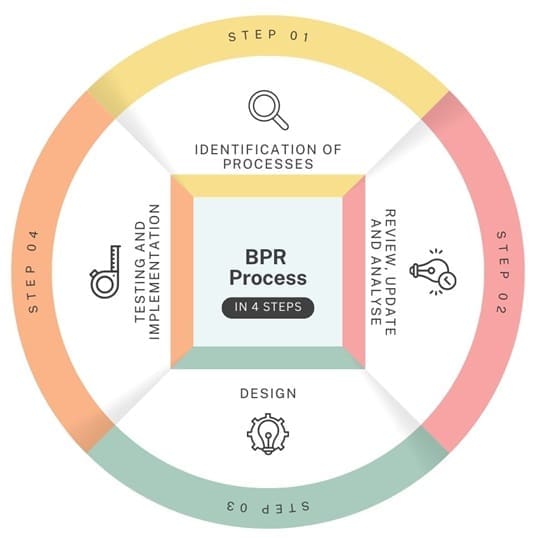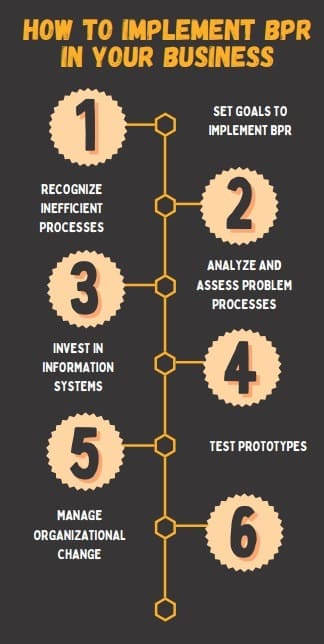Business Process Reengineering (BPR) is an indispensable way for organizations to boost efficiency and stay competitive in today’s market. BPR involves restructuring processes to achieve significant improvements that align with an organization’s strategy; ultimately transforming organizations by directly impacting overall performance.
Table of contents
What Is Business Process Reengineering (BPR)?
Business Process Reengineering (BPR) is an approach that transforms how a company operates to produce dramatic increases in performance and efficiency. Redesigning core processes involves streamlining workflows, eliminating unnecessary steps and using resources better. These goals can all be attained through BPR.
BPR is more than a one-off project; it’s an ongoing journey of innovation and optimization across organizations of all sizes and industries using techniques such as process mining to analyze and improve processes.
BPR requires effective leadership, change management and an ongoing dedication to continuous improvement. Its primary aim is to significantly increase productivity, cycle times, quality and customer satisfaction – something BPR strives for with every initiative it undertakes.
Public, Onsite, Virtual, and Online Six Sigma Certification Training!
- We are accredited by the IASSC.
- Live Public Training at 52 Sites.
- Live Virtual Training.
- Onsite Training (at your organization).
- Interactive Online (self-paced) training,
History
Michael Hammer first introduced Business Process Reengineering (BPR) through an article in Harvard Business Review published during the late 1990s. Together with James Champy, they later published “Reengineering the Corporation“, an influential book that highlights the need to break from traditional practices and focus on process-centric organizations for improved performance.
This book advocates for radical redesign and reorganization to increase service quality while decreasing costs, using IT for this purpose. BPR involves fundamentally revising business processes for improved performance.
Business processes are structured sets of activities designed to produce specific outputs for customers or markets. BPR encompasses two elements, which are the business processes themselves as well as a radical redesign that brings significant performance improvements.
Characteristics of BPR
BPR (Business Process Reengineering) involves redesigning and restructuring business processes to achieve significant increases in performance, efficiency, and effectiveness. Some key characteristics of BPR include:

- Inputs: These are the data or materials that initiate a process. For customer service processes, inputs could include inquiries or orders from customers while for manufacturing processes it could include raw materials or components that make up parts of a production line. Identifying and effectively managing these inputs are paramount to its success.
- Processing: On the receipt of inputs, they undergo processing in various steps or stages. Depending on their outputs and needs, processing could involve various tasks, procedures or operations to transform these inputs into desired outputs. BPR initiatives often use this stage to identify and eliminate unnecessary or redundant steps that consume both time and resources without adding value.
- Outcome: BPR measures outcomes by their successful delivery to customers or end users – such as filling a customer service request, manufacturing a product, or providing services. Their goal is to streamline processes to achieve desired outcomes more efficiently and meet or surpass customer expectations efficiently and effectively.
Examples of Business Process Reengineering
Some notable examples of BPR include:
Ford
Ford
abandoned invoice systems for online database orders instead, leading to a 75% reduction in the accounts payable workforce.
Taco Bell
Taco Bell centralized food preparation outside their restaurants in central commissaries to increase quality control and employee morale, leading to their growth from $500 million to $3 billion company.
Hallmark
They implemented a reengineering effort, shortening product development time from three years to eight months by identifying inefficiencies in the planning and conceptualization stages, as well as by creating cross-functional teams dedicated to product creation.
Kodak
Kodak implemented a groundbreaking product development reengineering initiative using computer-aided design and manufacturing technology, which allowed its design engineers to collaborate more efficiently while cutting time between concept to mass production by nearly half.
Furthermore, concurrent engineering enabled the company to involve tooling design engineers earlier in the process. It results in cost savings and better manufacturing results.
IBM
At IBM credit executives made extensive use of information technology to eliminate unnecessary experts and speed up information flow.
Also Read: What is Enterprise Resource Planning?
Process Reengineering
Business Process Reengineering (BPR) focuses on changing processes rather than restructuring departments or tasks to streamline operations, reduce costs, and enhance productivity by eliminating unnecessary tasks.
An excellent example of BPR implementation would be Ford’s Accounts Payable Process which transitioned from invoice-based billing to an invoice-less system which resulted in a 75% decrease in administrative staff.
BPR involves the analysis and redesign of interconnected business activities such as product development or customer order processing, to enhance efficiency, economy, and quality.
Among its steps are increasing customer satisfaction ratings using technology-enhanced core process redesigns; creating cross-functional teams; addressing organizational challenges; and implementing improvements across an organization.
BPR involves companies beginning over, and reimagining existing processes to provide superior value for customers.
Companies adopt new value systems, reduce business layers and eliminate unproductive activities – these processes include cost and cycle time reductions as well as supply chain management, inventory control and quality improvement processes within manufacturing companies.
Reengineering helps streamline operations while maintaining clear ownership over processes for improved cost, cycle time reductions, inventory control and quality enhancement.
BPR Process
BPR (Business Process Re-engineering) involves comprehensively restructuring how an organization operates, going beyond mere improvisation. It aims to better align work processes with the mission of the organization, lower costs and enhance overall performance. BPR typically takes several phases:

- Identification of Processes: This step involves identifying all of the processes performed by employees within your organization.
- Review, Update and Analyse: After the identification of processes, this phase analyzes current systems and possible ways of improving efficiency.
- Design: When developing new processes, designing them with an organizational objective in mind is an integral step. Logic must support organizational objectives.
- Testing and Implementation: At this final step, testing of newly designed processes takes place. This is against user requirements and resource utilization to make sure they meet these objectives successfully. If successful, implementation occurs; otherwise, they require further reengineering efforts.
Also Read: What is Business Process Management?
How To Implement Business Process Reengineering In Your Business?

- Set Goals to Implement Business Process Reengineering in Your Company: Set clear and measurable objectives aligned with your company’s vision and mission. They can be cost savings, product quality enhancement or efficiency increases.
- Recognize Inefficient Processes: Examine each process to pinpoint those that are underperforming or could be improved, particularly any that directly impact output or are at odds with your company’s mission.
- Analyze and Assess Problem Processes: Identify why these processes are inefficient by understanding why they take too long or compromise quality; compare these processes against industry standards or competitor practices to make informed decisions.
- Invest in Information Systems: Implement effective IT systems that support BPR initiatives to monitor and oversee changes effectively. These are essential for successful change management.
- Test Prototypes: Before making changes permanent, testing prototypes is a good way to identify any flaws. Use your failures during testing as learning opportunities and address limitations before scaling up.
- Manage Organizational Change: Prepare your organization for change by revising documentation, organizational structures and governance models to enable a smooth transition process. Ensure roles and responsibilities are clear to allow for an easy transition process.
Also See: Lean Six Sigma Certification Programs, San Jose, California
Success Factors of Business Process Reengineering
Success factors for Business Process Reengineering (BPR) depend on several key elements similar to Total Quality Management (TQM). The U.S. General Accounting Office has identified five principles which define successful BPR implementation:
1. Top management must actively support and participate in reengineering efforts to drive success.
2. Culture should embrace goals and principles associated with reengineering efforts.
3. Focusing on processes over individual functions can bring significant improvements.
4. Processes chosen for reengineering should take into account customer needs, anticipated benefits and success rates.
5. Reengineering projects should be overseen by process owners with cross-functional teams working under proper scope, customer-focused metrics and timeline adherence as priorities.
What BPR Isn’t?
BPR can often be misunderstood as similar to other business improvement programs like automation, downsizing or restructuring – yet it differs significantly.
First and foremost, Business Process Reengineering (BPR) should not be confused with automation. While technology plays an essential part, BPR goes far beyond automating existing processes. That is simply automating them might not address any potential inefficiencies within your operations.
Second, BPR differs from restructuring or downsizing in that it seeks to achieve more with limited resources than either of those approaches can. Restructuring requires decreasing capacity to meet lower demand; downsizing means doing less with limited resources whereas BPR seeks to accomplish more while spending fewer resources.
Final Words
BPR should not be confused with reorganizing or restructuring an organization; though it may result in flatter structures. Instead, its main concern lies with process structures – not organizational ones. Simply overlaying new organizations over old processes will not suffice. Doing so would be equivalent to patching an old cloth with a new thread.

About Six Sigma Development Solutions, Inc.
Six Sigma Development Solutions, Inc. offers onsite, public, and virtual Lean Six Sigma certification training. We are an Accredited Training Organization by the IASSC (International Association of Six Sigma Certification). We offer Lean Six Sigma Green Belt, Black Belt, and Yellow Belt, as well as LEAN certifications.
Book a Call and Let us know how we can help meet your training needs.




















